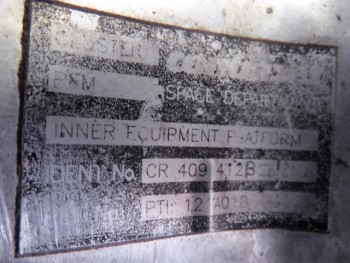It’s been said that space exploration is tough, really tough. Yet, disastrous as some flights may be, all instances of “rapid unscheduled disassembly” can teach engineers how to improve their rockets, ultimately making spaceflight better and safer.
At ESA’s ESOC control centre in Darmstadt, Germany, some remnants of the first four Cluster satellites – lost together with Ariane flight 501 which failed during launch in 1996 – are teaching us something different – about art.
German artist Sascha Mikloweit’s work explores the intersection of violence and aesthetics, and when he heard that some debris of the first Cluster craft were available, it was a natural decision to ask how they could be used in a project.
He was at ESOC in August, working diligently to create a series of very high-resolution digital scans, which will be developed into a new installation in the near future.
The timing is perfect: In 2015, the Cluster II mission is celebrating 15 years in orbit, and Sascha hopes his work can help promote the unqualified scientific success that is Cluster, as well as the work done by teams at ESA and across Europe who have contributed to its success over two decades.
Q1: What sort of art project do you envision from these scans?
Sascha: One that showcases the intricacy and beauty of the Cluster debris, and through it, the perseverance of rebuilding and launching again – with a mission that has now been flying much longer than planned. Ultimately, the core of the exhibition is also for the mission control teams and scientists.
Q2: What got you on to this project? How did you get into contact with ESA?
Sascha: Through a colleague, Cluster’s Spacecraft Operations Manager, Bruno Sousa, at ESOC, learned about a project I did in the UK a few years ago. Central to it was the debris of a real, ordinary briefcase that was detonated by the London Transport Police on the suspicion of it being a terrorist device – a ‘bag left unattended’ – at a large railway station.
Back then I developed a method of handling such materials with a scanner. When I learned about the debris of the original Cluster I mission – which unfortunately, being on board the maiden flight of Ariane 5, ended after 37 seconds in an explosion back in 1996 – and that some of its debris were available at ESOC, Bruno and I had a conversation and eventually decided to make it happen.
Q3: What’s involved in making the scans?
Sascha: A human to handle the machines, a computer to process the data, a hacked high-resolution graphic scanner to record the pixels, some really good scanning software called SilverFast Ai Studio 8 and, of course, access to some pieces of mind-blowing aerospace debris that helped write history.
Q4: How does art help support public engagement with science?
Sascha: Art can shift the spectators’ perspective on science. It can expose facets of scientific systems or processes that usually do not receive wider attention or remain hidden – like these chunks of metal and composite material. More than debris, they’re actually entry-points to getting excited about the science that Cluster performs, or the processes that the Flight Control Team use to manage the complex day-to-day operations, to the coding of software for a rocket launch.
Biography
Sascha Mikloweit trained in fine art in Düsseldorf, Münster and at Central Saint Martins, London. Following an interest in violence and aesthetics, his work addresses the realm of public security and ideology. Format and medium are determined in the process of subject-specific engagement and analysis, often involving installation, situational settings, moving image, print and projection. Sascha Mikloweit has exhibited in South Korea, Brazil, Canada, Turkey, the UK, Austria, Poland and Germany. His work is held in public and private collections in Europe and North America. He lives and works Berlin. More information via https://www.mikloweit.net.
Sascha Mikloweit upcoming shows
- Reality is a disappointment, 14th Istanbul Biennial / Galerist Istanbul, Istanbul, Turkey. (Collaboration with Ali Emir Tapan) 09/2015
- Schizm #8, ASP book fair at ICA, London, UK 09/2015
- Unexpected Visitor, Unexpected Visitor Project / unexpectedvisitor.com, Istanbul, Turkey 10/2015


Discussion: no comments